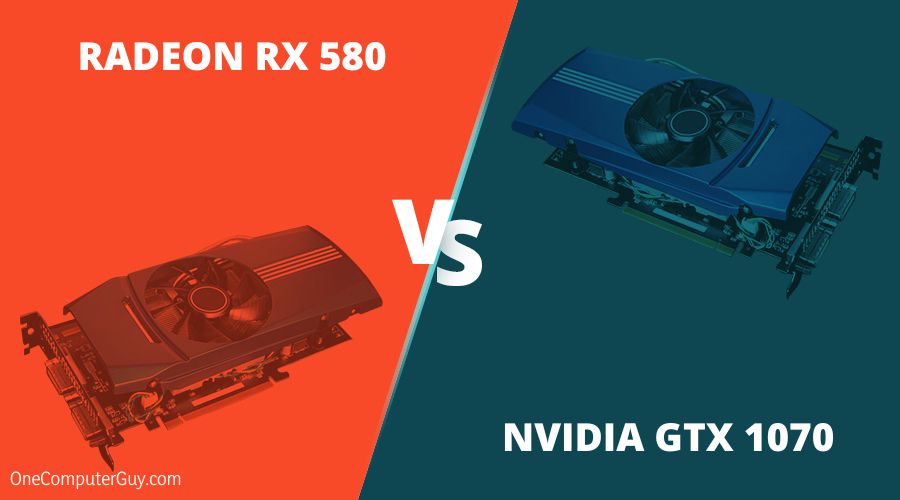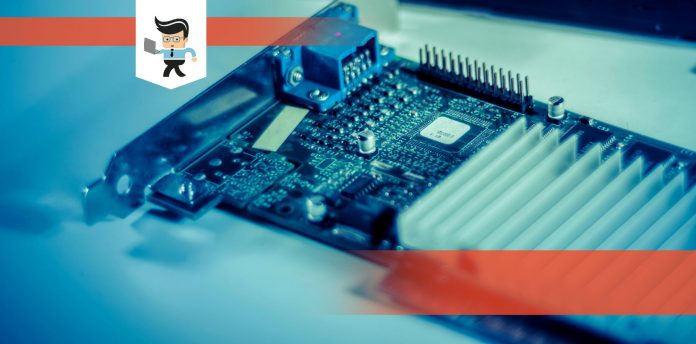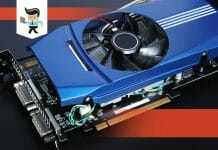GPU comparison between NVIDIA graphics cards and Radeon graphics cards is often an unfair pairing, even when the GPUs are from the same generation of processors. The NVIDIA cards tend to exceed the Radeon cards in terms of memory speed and graphics processing units.
 The NVIDIA GTX 1070 is one generation newer than the Radeon RX 580 and follows this same pattern. The RX 580 is a significantly cheaper card than the GTX 1070, which is an important deciding factor for many people when selecting their graphics cards.
The NVIDIA GTX 1070 is one generation newer than the Radeon RX 580 and follows this same pattern. The RX 580 is a significantly cheaper card than the GTX 1070, which is an important deciding factor for many people when selecting their graphics cards.
Whether the intended application is gaming, crypto mining, or high-demand video applications, the RX 580 and the GTX 1070 each have their strengths and advantages in different scenarios.
Contents
GTX 1070 vs RX 580
The GTX 1070 and the Radeon RX 580 are both midrange graphics cards that offer decent performance for not a lot of money. The RX 580 NVIDIA equivalent is the GTX 1060, which is the generation preceding the GTX 1070. The GTX 1070 AMD equivalent is the Radeon RX Vega 56, which is significantly newer than the Radeon RX 580.
In the table below, we compare the RX 580 specs to the GTX 1070 specs, as well as including a comparison with the GTX 1060, the RX 580 NVIDIA equivalent and the Radeon RX Vega 56 which is the GTX 1070 AMD equivalent.
A few things to keep in mind with this comparison:
- Both the RX 580 and the GTX 1070 are midrange graphics cards
- The Radeon RX 580 was designed as a direct compete to GTX 1060 upon its release
- The GTX 1070 was one of the first cards created by NVIDIA after the die shrink from 28 nm to 16 nm, reducing the footprint of the silicon architecture by almost half.
| Radeon RX 580 | NVIDIA GTX 1060 | Radeon RX Vega 56 | NVIDIA GTX 1070 | |
| CUDA cores | N/A | 1280 | N/A | 1920 |
| Stream Processors | 2304 | N/A | 3584 | N/A |
| ROPs | 32 | 48 | 64 | 64 |
| Base Clock | 1257 MHz | 1506 MHz | 1156 MHz | 1506 MHz |
| Boost Clock | 1340 MHz | 1708 MHz | 1471 MHz | 1683 MHz |
| Float Performance | 6.2 TFLOPS | 3.7 TFLOPS | 10.54 TFLOPS | 6.463 TFLOPS |
| GPU | GDDR5 | GP106 | Vega 10 | GP104 |
| Architecture | Polaris | Pascal | Vega | Pascal |
1. Radeon RX 580
The Radeon RX 480 came out less than a year prior to the RX 580, and one of the reasons that AMD got the RX 580 to market so quickly after the 480’s release was as a direct competitor to the NVIDIA product of the time, the GTX 1060, which had just moved from the 28 nm silicon architecture to the 16 nm new technology with their Pascal line.
Even though the Radeon RX 580 specs are lower than those of the 1060 it competed against, it routinely provided higher framerates and speeds compared to the 1060 card. The GTX 1070 outpaced both of them when it arrived on the market and to this day retains a higher market share than the RX 580.
Next we will take a look at some of the key benchmark metrics from the RX 580 and why it is a good graphics card.
RX 580 Benchmark
- 60th of 635
- 3.27% of market share
- Passmark Score of 7,781
- Clock Speed of 1,257 MHz
- 42.88 GPixel/s
- PassMark direct compute score of 3,923
- Firestrike score of 75.63
- 185 Watt TDP

Even several years after its release, the RX 580 can hold its own in the midrange graphics card market. Even though it has a smaller market share than the GTX 1070, it is only by a fraction, coming in 0.2% behind the GTX 1070.
2. NVIDIA GTX 1070
- One of the first cards built after the die shrink from 28 nm to 16 nm on the new Pascal architecture
The NVIDIA GeForce 1070 card comes in at 35th out of 635 results in the Passmark scores, superseded primarily by later NVIDIA models and some of the Radeon RX Vega cards.
The GTX 1070 hit the peak of its market value in February of 2018 when it reached almost six hundred and eighty five dollars. This spike in value was immediately following the significant drop in the value of bitcoin at the end of 2017. Part of the reason for this is the fact that the GTX 1070 is a good candidate for mining cryptocurrency, which is discussed in a later section.
The GTX 1070 benchmark consistently outperforms the RX 580, some highlights of which are summarized below and then compared to the RX 580 in the section thereafter.
GTX 1070 benchmark
- 35th of 635
- 47% of market share
- Passmark Score of 11,028
- Clock Speed of 1,506 MHz
- 4 GPixel/s
- Passmark direct compute score of 6,724
- Firestrike score of 87.79
- 150 Watt TDP
GTX 1070 Benchmark compared to RX 580 Benchmark
- The GTX 1070 is better at: lighting, Mrender, Gravity, reflection, parallax, and splatting
- Slightly higher market share (3.47% for the NVIDIA compared to 3.27% for the AMD)
- Better PassMark score: the GTX 1070 scored 11,028 on Passmark vs 7,781 for the RX 580. The GTX 1070 scored more than 40% better on PassMark than the RX 580.
- Higher clock speed: The GTX 1070 has a base clock of 1,506 MHz compared to 1,257 MHz for the RX 580, meaning the GTX 1070 has around 20% higher clock speed than the RX 580.
- Significantly higher pixel rate 96.4 GPixel/s vs 42.88 GPixel/s Around 2.2x higher pixel rate
- Significantly higher turbo clock speed: The GTX 1070 has a turbo clock of 1,683 MHz vs the turbo clock on the RX 580 of 1,340 MHz. This means the 1070 has more than 25% higher turbo clock speed than the RX 580.
- Significantly better PassMark direct compute: the GTX 1070 score is 6,724 vs 3,923 for RX 580. The 1070 scored more than 70% better with the PassMark direct compute score.
- Lower TDP: The GTX 1070 has a TDP of 150W vs 185W for the RX 580, meaning that the power consumption of the GTX 1070 is around 20% lower TDP.
Cryptocurrency Mining
Mining cryptocurrency does not have the same buzz that it did a few years ago, but Bitcoin is still very popular and other cryptocurrencies are rising in the market, which means that many people are still in the market for a GPU that will help them mine cryptocurrency.
In order to make the most of your investment, you have to choose one of the best mining GPUs, if you’re thinking about delving into mining cryptocurrency. The drop in popularity by no means is an indicator that it’s dead. Bitcoin, Ethereum and other crypto coins are still flowing, while others are booming, which means that there’s still a demand for mining GPUs.
When you go shopping for the best mining GPU, it is a balance between memory, power requirement, and upfront cost. It’s important to consider the value of the GPU, because when you start mining, you won’t be yielding large amounts of cryptocurrency to start. Minimizing your initial costs as much as possible is ideal.
You don’t want to go out of your way to buy a very expensive graphics card, only to give up on mining shortly afterward and sell off the card at a discount when you can’t make enough to break even because you were told that crypto mining is like printing your own money.
Make sure that the card you get has enough memory to handle the mining operation, has a power requirement low enough that even when running at full capacity mining it will not drain your profits when you have to pay the power bill, and has a low enough upfront cost that you don’t spend too much time trying to earn back your initial investment before you start to make money.
Keeping price and efficiency in mind, the NVIDIA GeForce GTX 1070 and the AMD Radeon RX 580 are both good candidates for crypto mining.
– GTX 1070 for mining
The Nvidia GeForce GTX 1070 is a great graphics card for gaming, but it’s also an excellent mining GPU. The GTX 1070 maintains a high hash rate of around 30 mh/s without needing too much power. The more power a GPU requires, the more expensive it is to run. The more power you use for mining, the more you will eat into your cryptocurrency profits. The GTX 1070 has only 150 Watts TDP compared to the 185 Watts TDP of the Radeon RX 580.
As with many recent Nvidia GPUs, the 1070 is on the pricey side, so you will have to take an initial hit when starting up. If you’re planning to get into cryptocurrency mining for the long run, the 1070 is easily the best mining GPU currently available by balancing specs, price, and power requirements.
– Radeon RX 580 for mining
The AMD Radeon RX580 is another one of the best GPUs you can use for mining, so much so that it has become a bit of a victim of its own success. Because the RX 580 is so good for mining, it can sometimes be difficult to find.
The card’s popularity is well earned. It offers an excellent hash rate of 29 mh/s while also keeping the electricity consumption low. It is cheaper overall than the GTX 1070, and if you don’t mind changing some of the settings of the care, you will be very pleased with this card performance.

It does, however, have a TDP that is higher than the GTX 1070 by 35 Watts. This means that at full capacity, the RX 580 card will consume almost a kilowatt more per day than the GTX 1070 will. Depending on your location and the amount of mining you do, the result of this power difference could add up to serious profit losses over the lifetime of the mining operation.
Conclusion
Overall, regardless of what application you intend to use the graphics card for, whether it is gaming or mining cryptocurrency, the GTX 1070 is the better card.
The 1070 has significantly higher benchmark numbers and lower power consumption, meaning the drain on the system is lower.
Because the RX 580 was created as a direct competitor to the GTX 1060 and the GTX 1070 is the next NVIDIA generation, it should come as no surprise that the NVIDIA GTX 1070 is the clear winner, and if you want an AMD graphics card that will exceed the GTX 1070, you need to upgrade to a better card like the Radeon RX Vega 56.







